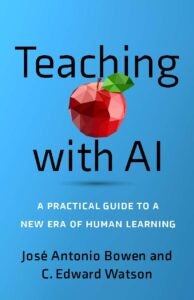Decoding AI in Education: Insights from Your ECU Colleagues
The buzz around Artificial Intelligence (AI) in higher education can feel overwhelming, especially if you’re uncertain about its practical implications for your teaching. This spring, a group of your ECU colleagues engaged in thoughtful discussions as part of a book group focused on Bowen and Watson’s Teaching with AI: A Practical Guide to a New Era in Human Learning (Johns Hopkins Press, 2024). Their conversations offer valuable insights into how AI might reshape our classrooms and the student learning experience.
Here’s a glimpse into four key areas we explored during our three meetings:
One central theme revolved around rethinking our perception of AI. Instead of solely viewing it as a tool for potential academic dishonesty, faculty members discussed its potential as a collaborative learning partner. They considered how AI could help students break down large assignments, quickly grasp complex information, and even explore different sides of an argument to enhance critical thinking. For example, using AI to create timelines for completing their projects or to summarize research papers could free up students for deeper analysis and help them structure their time more effectively on longer, multi-week projects. We also explored the idea of students dialoguing with AI and then reflecting on that process to demonstrate their understanding of new concepts.
Another significant area of discussion focused on pedagogical shifts and the need to adapt our assignments. There was a recognition that traditional assessments might not effectively gauge student learning in an AI-rich environment. In our discussions, we explored the importance of clearly communicating the purpose and value of assignments to students. We also discussed designing tasks that emphasize the learning process, such as incorporating drafts and revisions. The need to teach and assess critical evaluation skills became paramount as we explored ideas for having students critique AI-generated content. Exploring alternative assessment methods beyond traditional essays was a major discussion point as we wondered whether other genres or writing projects might better engage student learners at this moment. While it’s familiar, is “the essay” always the best writing genre for the task at hand?
Naturally, ethical considerations and maintaining student engagement were also key concerns. Faculty acknowledged the inherent biases in AI algorithms and the importance of guiding students to critically evaluate AI outputs. Transparency in AI usage seemed like a given with this group, with some suggesting students should always cite when they use AI and others recognizing that traditional citation methods may no longer make sense for AI-generated content and thus we would need new methods acknowledging sources. Another crucial discussion centered on the need to foster student buy-in by highlighting the value of learning and human skills in an AI world. Rather than just faculty exploring the idea, we discussed the need to turn the question back to students: in an age of AI, what use do you have to the world? What can you bring to the conversation that AI cannot? AI can do a lot quickly, but part of student engagement should be about excavating the human element that machines cannot replicate or replace.
Finally, the group explored practical applications of AI and considered institutional implications. Participants shared examples of using AI to brainstorm activities, generate different perspectives for discussions, and even create more accessible learning materials like podcasts from transcripts. Tools like Notebook LM, which allow users to control the sources AI draws from, were discussed, and we even took transcripts from our three Teams meetings and provided them to Notebook LM so that it could generate podcasts of those transcripts. The links below are those three podcasts in MP3 format, unedited. Feel free to listen to Notebook LM’s “deep dive” podcasts to hear more about our discussions.
Nothing about AI is settled, that’s for sure, but faculty need to be engaged in these discussions in meaningful ways so that we can help guide campus policies and procedures. While AI can feel overwhelming because of its speed and near immediate ubiquity, it’s not the first technology to revolutionize education – and it won’t be the last. While teachers have always struggled with innovation and the ways it upends our daily work, we have also repeatedly met that struggle by rethinking and reimagining teaching and learning. Faculty at ECU seem ready for that challenge!
AI Composing Note:
In composing this blog post, Will Banks took the three transcripts from the Spring 2025 Teams meetings and uploaded them to Google’s Notebook LM AI platform as PDFs. Then, he entered the following prompt: “Write a 500-word blog post about the four main topics of discussion across these transcripts. The audience for this blog post is other faculty on ECU’s campus who are uncertain about AI but interested in what it might do to impact college teaching and learning. They are curious what their colleagues discussed as part of the Spring 2025 book group that read the book Teaching with AI.” Will also tried having it write a 250-word post and a 750-word post, and the middle version most accurately captured the main points based on Will’s memory of the three meetings. Will then revised and edited the blog post that AI created. The most prominent change involved manually modifying the post from passive to active voice, adding specifics about the book and the meetings, like the information about the podcasts, and then deleting the conclusion AI had written and creating a new concluding paragraph. The AI had created a conclusion that sounded like a marketing/sales pitch rather a summative response to the event.
Learn more about our book from this spring and other books from past book groups here.
